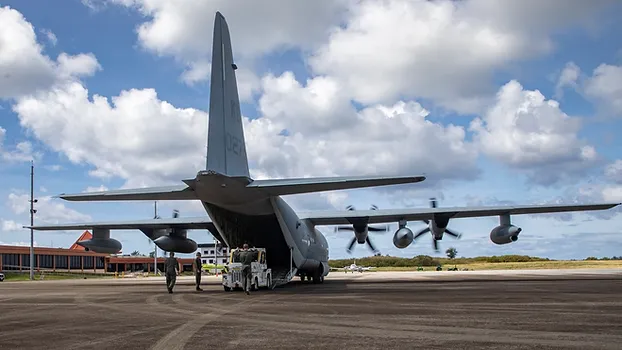In the face of escalating threats in the region, Commonwealth of the Northern Marianas (CNMI) House Floor Leader Edwin Propst said Guam and the Northern Marianas must join hands in preparing the island communities for any potential conflict.
“We have the ideas, the determination and the ability to succeed so long as we work together hand in hand, ensuring that we look after each other,” Propst said Thursday at the opening of the Mariana Islands Legislature Association’s second general assembly at the Guam Congress Building.
“It is important that we stay unified with one voice, with one heart, with one Marianas,” he added.
As the most forward U.S territories in the Pacific, Guam and CNMI are considered critical to U.S defence and power projection across the region.
The Guam missile defence system is a top homeland defence priority for the Indo-Pacific Command and is central to enabling robust theater logistics, according to a Tactical Decision Aid document prepared and released last year by the Indo-Pacom’s Joint Operational Law Team
“Sea Ports in Guam and CNMI are a three-day sail from Taiwan, South Korea, and Japan, and a seven-day sail from Hawaii. Airports in Guam, Saipan and Tinian enable direct flights to and from the U.S” the document noted.
The Department of Defenxe is building a divert airfield on Tinian.
The Indo-Pacom report acknowledged that Guam and the CNMI are facing conventional threats from China. “Specifically, both Guam and CNMI are within the 2500-mile firing range of the DF-26 intermediate ballistic missile dubbed the ‘Guam Killer’ in Chinese media outlets,” the report said.
Propst warned that the growing regional tensions “put every one of us in the Marianas at risk if a war, God forbid, breaks out. We pray that that never happens, but we must always be prepared,” he added.
For better preparations, Propst said Guam and CNMI leaders must hold more regular meetings. “The outcome of the meetings benefits us all when we are able to achieve affordable transportation between our islands,” he added.
At the MILA assembly held from 10 – 12 July, Guam and CNMI lawmakers tackled regional issues affecting both jurisdictions including airfare costs, labor and healthcare, among others.
“This assembly stands as a testament to our collective commitment to the progress and well-being of our beloved Mariana Islands,” Speaker Therese Terlaje of the Guam legislature, said in her opening remarks.
“Our presence here today reflects our shared dedication to addressing the diverse and evolving needs of our communities, and in the face of challenges we continue to demonstrate resilience, innovation and unwavering spirit of cooperation” she added.
“This assembly is not just a platform for dialogue but a beacon of our unity and our shared vision for a brighter future as we deliberate on the various matters at hand let us remember that our decisions and actions will shape the lives our constituents and its our duty to ensure that their voices are heard; their needs are met; their dreams are given the opportunity to flourish,” she said.
CNMI Senator Donald Manglona, for his part, said discussions at the assembly “are crucial not just for our individual territories but for the collective future of the Marianas.”
He said the CNMI team welcomed its partnership with Guam in dealing with common issues such as environmental sustainability, economic development and cultural preservation.
“With this continuous engagement and proactive collaboration, it is essential to make lasting progress,” he added. “We look forward to frequent assemblies on ongoing dialogue to achieve our shared goals so together we can create a brighter more prosperous future for our Marianas, said Senator Manglona.
CNMI, Guam lawmakers propose joint Marianas visa for both territories
The Marianas Islands Legislature Association (MILA) has adopted a resolution seeking to replace the CNMI’s foreign worker programme with a joint Marianas visa tailored to meet the unique needs of both Guam and the Northern Mariana Islands.
MILA unanimously passed Resolution 2-GA-05, which CNMI Rep. Ed. Propst introduced Friday on the second day of the MILA general assembly at the Guam Congress Building in Hagatna.
Propst’s resolution also recommends the creation of a federal Marianas Regional Commission to streamline federal programmes focusing on infrastructure, transportation, workforce development, military buildup, climate and environmental risks and other priority concerns of both Guam and the CNMI.
The resolution includes a provision requiring that any fees associated with the proposed Marianas Visa programme would not leave Guam and the CNMI but will be used for workforce development training in both territories.
Propst said the matter was urgent because the CNMI Transitional Worker Programme, popularly known as the CW-1 programme, will end on 29 December 2029.
The temporary-need exemption for certain H2B workers in Guam and the CNMI will also expire on the same date.
The CW-1 programme has a cap of 13,000 workers and is reduced by 1,000 yearly. In fiscal 2025, the CW-1 cap will be set at 9,000 and will not authorise hiring extraction and construction occupations.
The planned relocation of some 5,000 Marines from Okinawa to Guam, which is expected to start later this year is causing housing prices in Guam to skyrocket, causing concerns that Guam residents are now unable to afford rent or build new homes.
Brown said including the local construction industry among the beneficiaries of the proposed Marianas Visa would enable Guam residents to do major or minor construction.
Senator Celina R. Babauta also spoke to support the resolution and she urged Guam lawmakers to join the CNMI’s efforts by supporting it.
The non-binding resolution was one of several adopted by the assembly for submission to the U. S President and the U.S Congress.
